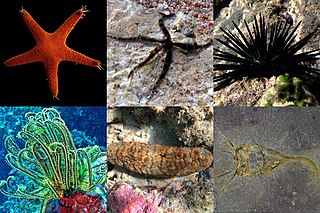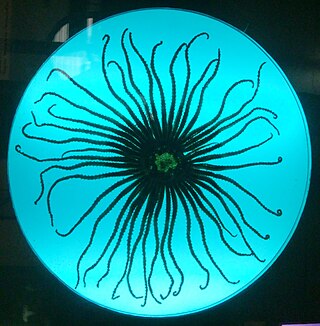
An echinoderm is any deuterostomal animal of the phylum Echinodermata, which includes starfish, brittle stars, sea urchins, sand dollars and sea cucumbers, as well as the sessile sea lilies or "stone lilies". While bilaterally symmetrical as larvae, as adults echinoderms are recognisable by their usually five-pointed radial symmetry, and are found on the sea bed at every ocean depth from the intertidal zone to the abyssal zone. The phylum contains about 7,600 living species, making it the second-largest group of deuterostomes after the chordates, as well as the largest marine-only phylum. The first definitive echinoderms appeared near the start of the Cambrian.

The rotifers, commonly called wheel animals or wheel animalcules, make up a phylum of microscopic and near-microscopic pseudocoelomate animals.

Starfish or sea stars are star-shaped echinoderms belonging to the class Asteroidea. Common usage frequently finds these names being also applied to ophiuroids, which are correctly referred to as brittle stars or basket stars. Starfish are also known as asteroids due to being in the class Asteroidea. About 1,900 species of starfish live on the seabed in all the world's oceans, from warm, tropical zones to frigid, polar regions. They are found from the intertidal zone down to abyssal depths, at 6,000 m (20,000 ft) below the surface.
The water vascular system is a hydraulic system used by echinoderms, such as sea stars and sea urchins, for locomotion, food and waste transportation, and respiration. The system is composed of canals connecting numerous tube feet. Echinoderms move by alternately contracting muscles that force water into the tube feet, causing them to extend and push against the ground, then relaxing to allow the feet to retract.

Brittle stars, serpent stars, or ophiuroids are echinoderms in the class Ophiuroidea, closely related to starfish. They crawl across the sea floor using their flexible arms for locomotion. The ophiuroids generally have five long, slender, whip-like arms which may reach up to 60 cm (24 in) in length on the largest specimens.

The Echinasteridae are a family of starfish in the monotypic order Spinulosida. The family includes eight genera and about 133 species found on the seabed in various habitats around the world.

Solaster paxillatus, the orange sun star, is a species of starfish found at varying depths in the northern Pacific Ocean. It is a natural predator of the starfish Asterias amurensis.

Sea anemones are a group of predatory marine invertebrates constituting the order Actiniaria. Because of their colourful appearance, they are named after the Anemone, a terrestrial flowering plant. Sea anemones are classified in the phylum Cnidaria, class Anthozoa, subclass Hexacorallia. As cnidarians, sea anemones are related to corals, jellyfish, tube-dwelling anemones, and Hydra. Unlike jellyfish, sea anemones do not have a medusa stage in their life cycle.

Pisaster brevispinus, commonly called the pink sea star, giant pink sea star, or short-spined sea star, is a species of sea star in the northeast Pacific Ocean. It was first described to science by William Stimson in 1857. The type specimen was collected on a sandy bottom, 10 fathoms (18 m) deep, near the mouth of San Francisco Bay.

The Asterozoa are a subphylum in the phylum Echinodermata. Characteristics include a star-shaped body and radially divergent axes of symmetry. The subphylum includes the class Asteroidea, the class Ophiuroidea, and the extinct order Somasteroidea.

Evasterias troschelii is a species of starfish in the family Asteriidae. Its common names include the mottled star, false ochre sea star and Troschel's true star. It is found in Kamchatka and the north western coast of North America.

Luidia senegalensis, the nine-armed sea star, is a tropical species of starfish in the family Luidiidae found in the western Atlantic Ocean.
Anasterias rupicola is a species of starfish in the family Asteriidae. It is found in shallow waters in the Southern Ocean and sub-Antarctic Indian Ocean.

Labidiaster annulatus, the Antarctic sun starfish or wolftrap starfish is a species of starfish in the family Heliasteridae. It is found in the cold waters around Antarctica and has a large number of slender, flexible rays.

The orange knobby star, Echinaster echinophorus, is a species of sea star found in the Caribbean Sea and along the Atlantic coast of South America.

Ophiactis savignyi is a species of brittle star in the family Ophiactidae, commonly known as Savigny's brittle star or the little brittle star. It occurs in the tropical and subtropical parts of all the world's oceans and is thought to be the brittle star with the most widespread distribution. It was first described by the German zoologists Johannes Peter Müller and Franz Hermann Troschel in 1842. The specific name honours the French zoologist Marie Jules César Savigny.

Neoferdina cumingi, also known as Cuming's sea star, is a species of starfish in the family Goniasteridae. It is native to the tropical Indo-Pacific region.

Echinaster is a well-studied and common genus of starfish containing ~30 species and is the second-largest genus found within the family Echinasteridae. The genera Henricia and Echinaster encompass 90% of all the species found within the family Echinasteridae. It contains 30 species, however the number of species in this genus is still debatable because of uncertainty within the genera. This genus is currently sub-divided into two sub-genera: Echinaster and Othilia, evolutionary relationships between the sub-genera is not understood. Echinaster are found in the Pacific, Atlantic and Indian oceans, with most species being studied in the Gulf of Mexico and Brazil. The sub-genera Othilia is thought to encompass species mainly found in the Gulf of Mexico and Brazil. Echinaster is often one of the most studied species within the family Echinasteridae and is often used to find evolutionary relationships.

Ophiomusa is a genus of echinoderms belonging to the family Ophiolepididae that includes: sea urchins, sand dollars and sea cucumbers. Ophiurida are similar to starfish; they both have a central disc and five arms sprouting from the disc. One of the main distinguishing factors of an Ophiuroid is its arms; the arms of an Ophiurida are longer, thinner, and distinctly separated in comparison to those of a sea star.

Rathbunaster is a monospecific genus of sea stars in the family Asteriidae. The genus name was given by Walter Kenrick Fisher to honor the starfish biologist Richard Rathbun of the Smithsonian Institution. He originally ranged this genus under the family Pycnopididae, synonymous with Asteriidae.

















